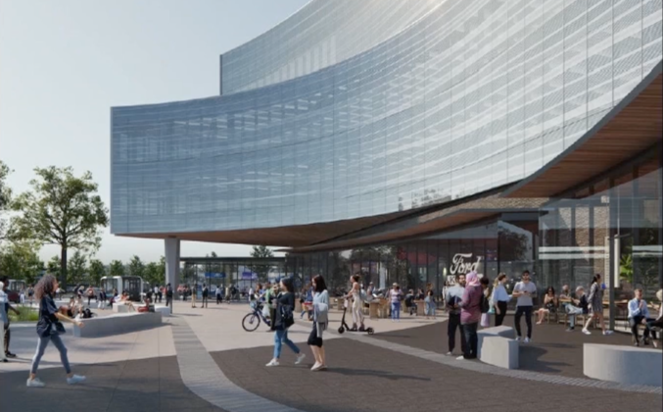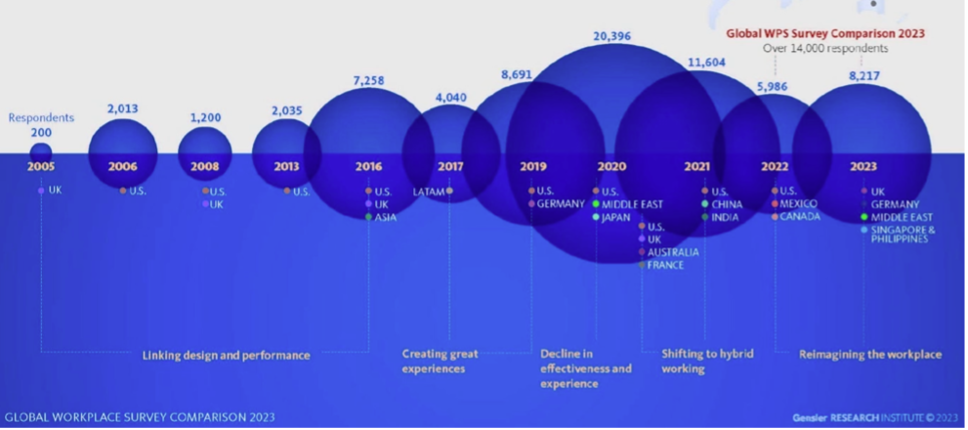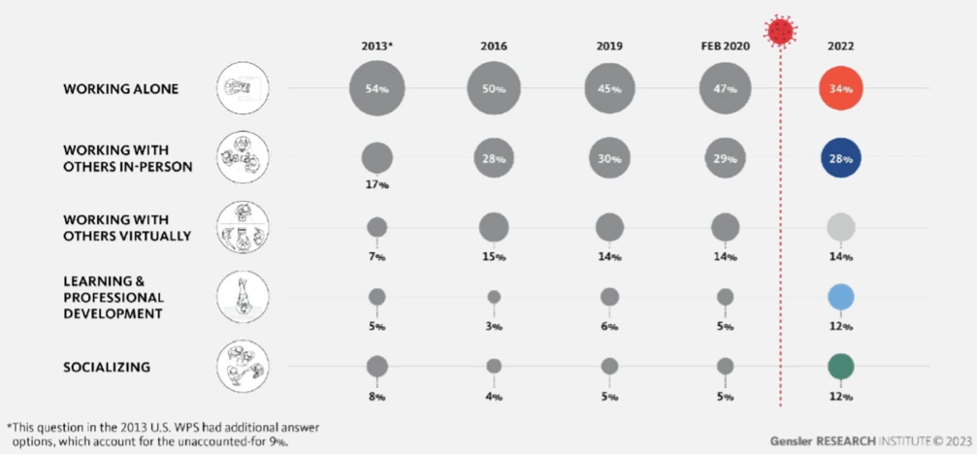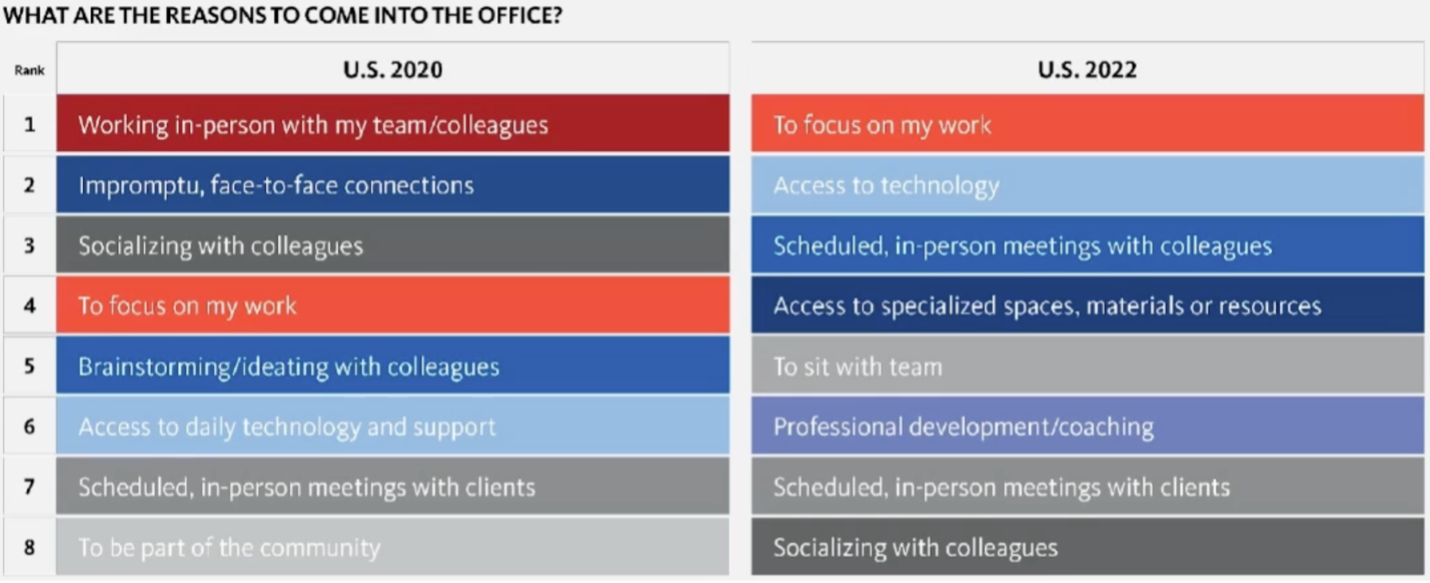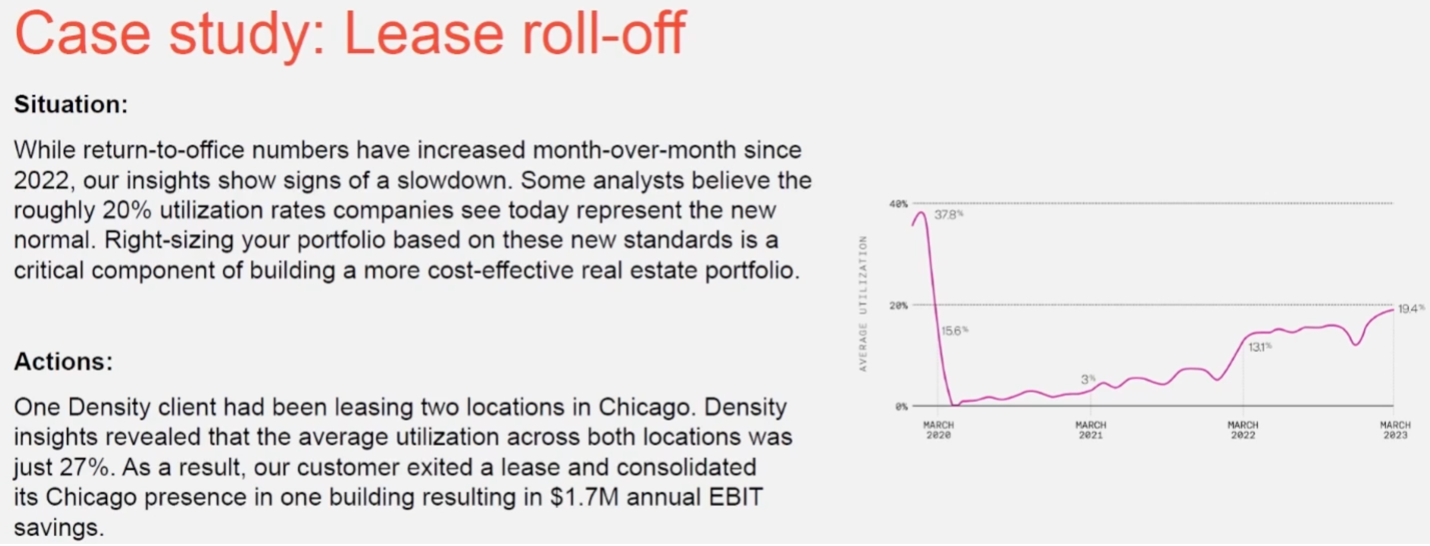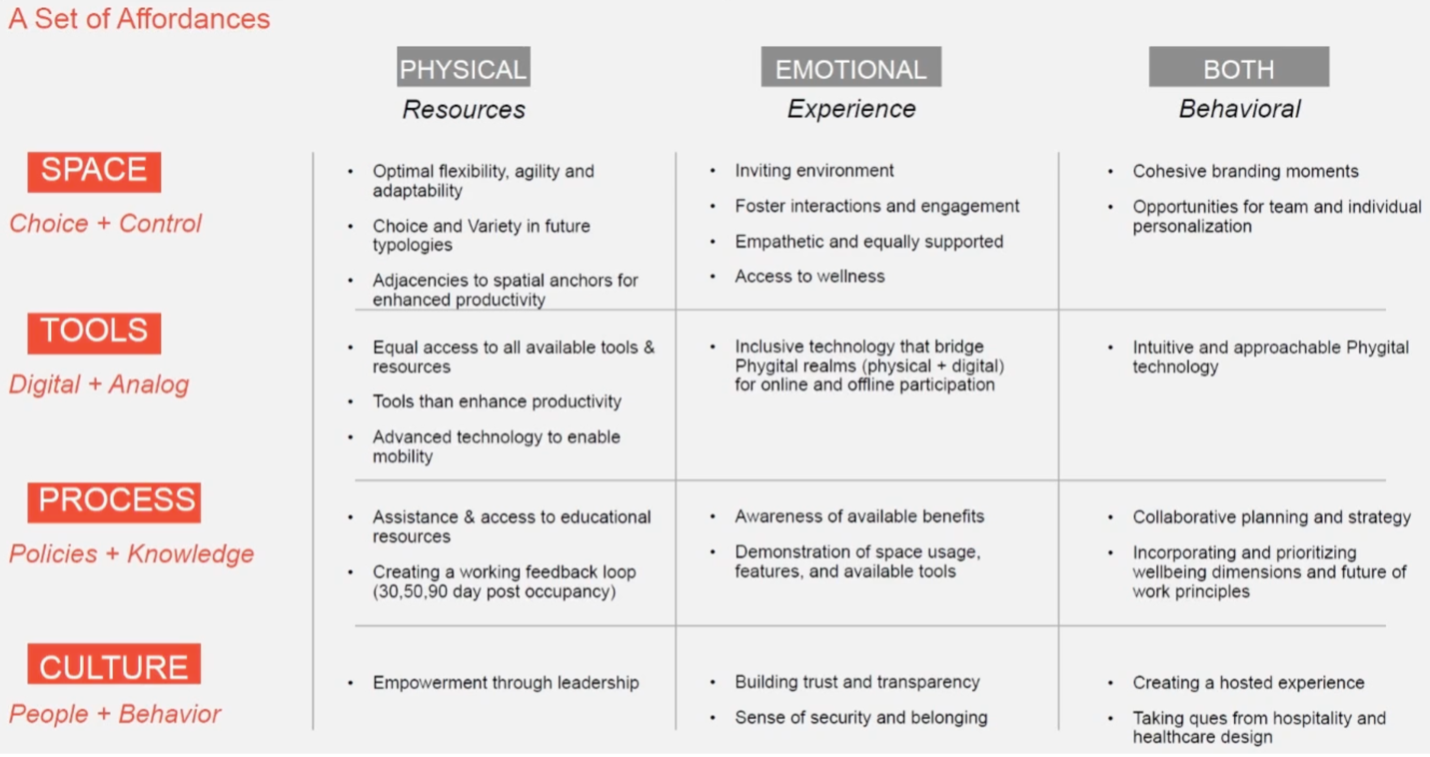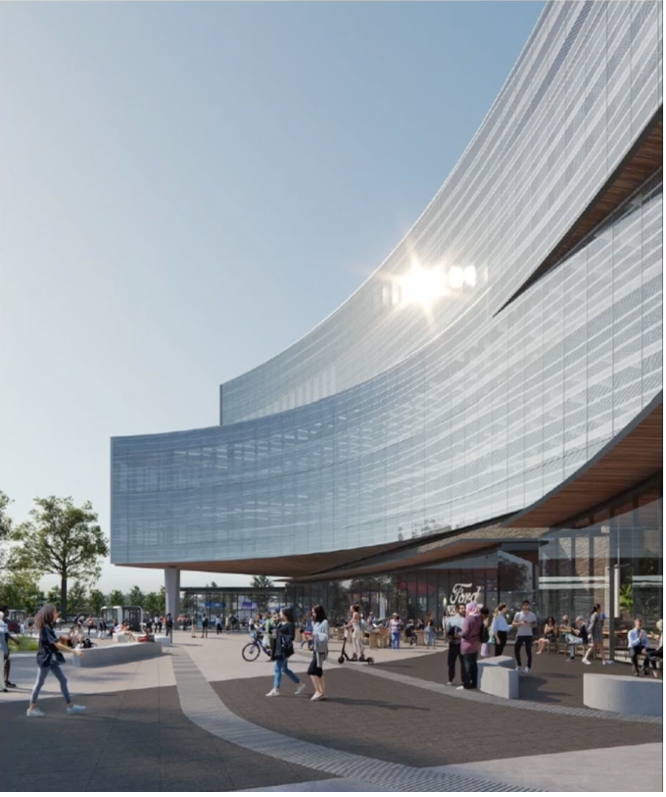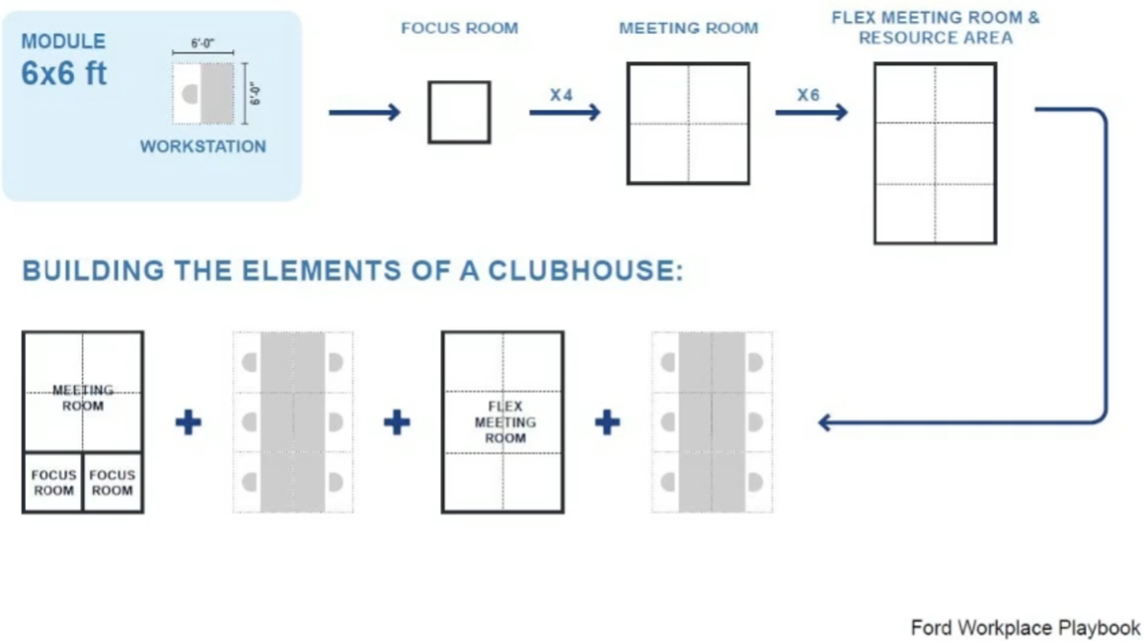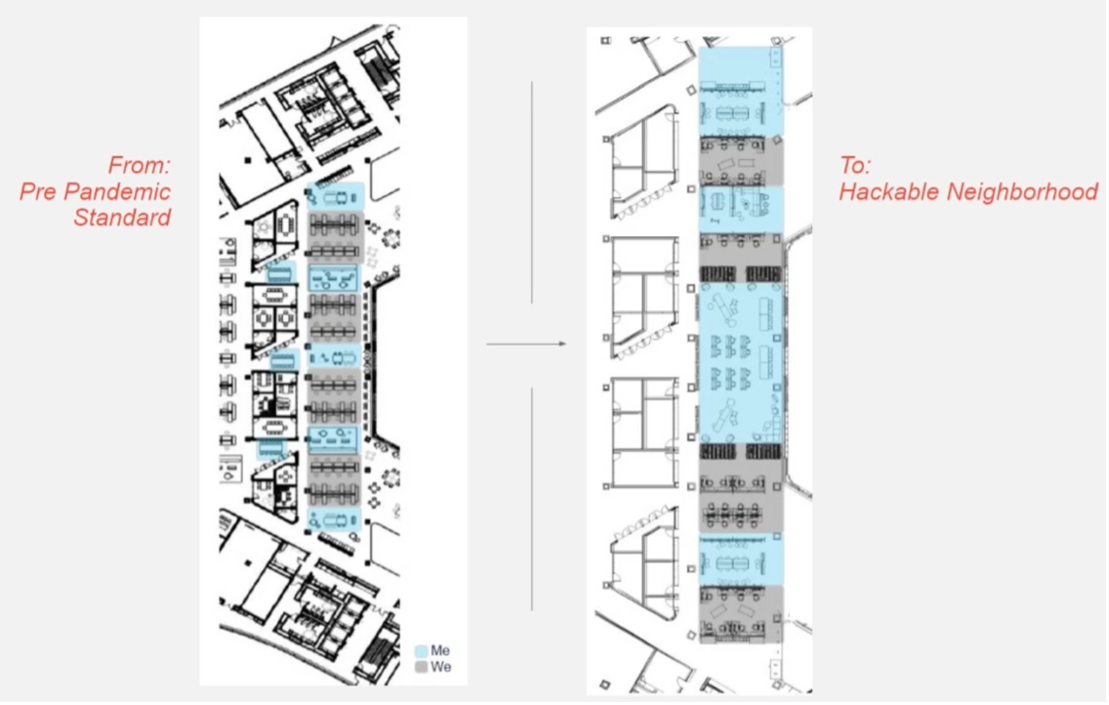Editor's Note: As part of our coverage on the new world of work, we'll be running recaps of virtual events from the NeoCon commercial design event, which took place from June 10-12, 2023. See our previous coverage of Salesforce’s deep-dive into the flexible design philosophy behind the company’s new tower in Chicago, IL.
In the NeoCon virtual session “Return to Office Data and Its Impact on The Office, From Floor Plans to Furniture,” Janet Pogue McLaurin, Global Director Workplace Research, Principal, at the Gensler Research Institute, Nellie Hayat, Workplace Transformation Leader at Density, and Julia Calabrese, Global Design & Brand Manager at Ford Motor Company spoke on the data, trends and design decisions that may encourage workers’ return to the office.
McLaurin began the session speaking about Gensler’s long history in studying the workplace, as shown in the nearby graphic. That graphic also highlights some of the trends they’ve identified over the past years. “Right before the pandemic, we saw a significant decline in both effectiveness and experience. The workplace was ripe for reinvention, because something was not working, and then the pandemic hit, and it accelerated what wasn't working already.”
To help diagnose what wasn’t working McLaurin said they’ve identified five work modes which they examine and re-examine with every survey they field. These modes do not necessarily speak to where people are working; they address social interactions embedded in the modes. The modes are: working alone, working with others (in person), working with others (virtually), learning and professional development (which includes mentoring, coaching), and socializing (which includes building social capital through connecting and networking).
Changing Levels of Work Modes
The nearby graphic illustrates how those work modes hardly changed since 2013 – the data provided suggests only slight decreases or increases in any of those modes. Until recently. Between 2020 and 2022, the percentage of respondents who reported “working alone” dropped from 47% to 34%. Interestingly, the two “working with others” categories are hardly changed (from 2020 to 2022) so it appears that collaboration has returned to its pre-pandemic level (as measured by Gensler’s categories and surveys).
The major change is the doubling of the last two categories “learning” and “socializing.” In her presentation McLaurin did not posit a theory as to why those categories doubled. It does appear, though, that those who spent most of their time “working alone” are now spending more time in those latter activities (because the percentages add to 100%).
With respect to where people are working, McLaurin said that in 2016 through 2020 (pre-pandemic) employees reported spending about 81% of the work week at the office. In their 2022 survey employees reported spending a little over half (51%) of the typical work week at the office. That's a 30% drop in office time.
The remaining 49% of the week was spent working in other places – e.g., at home, in coffee shops, traveling.
Focusing on Work
During the pandemic (2020), McLaurin said Gensler conducted 6 different U.S. surveys (and another 5 global surveys). During the pandemic, the number one reason to return to the office during the pandemic was “working in person with team/colleagues” (as shown in the left-hand column of the nearby graphic). In 2022, the list of reasons completely changed. Now, the top reason is to “focus on my work.” The other priorities have also shifted to work-focused activities versus socially oriented reasons.
As seen by the graphic, in 2020, the top three reasons to come into the office were all intensely social – working in-person, forging impromptu connections and socializing with colleagues. In just two years, survey respondents' foci shifted to an emphasis on access to resources that boosted individual productivity – focus, access to technology, and scheduled meetings that allow a person to retain some control over their time.
Adapt Design to Support Return to Work
McLaurin also said they measured the effectiveness of office space to support each of the five work modes (alone, with others, etc.). What they found is that, on average, as people return to their current offices those spaces are performing well for working with others, learning and socializing – and that was great for during the pandemic. But now, we’re post pandemic. As seen in the previous section, workers' reasons for coming to an office have shifted sharply.
Their recent U.S. survey asked respondents if they would be willing to come back to the office more often if their company/organization provided their ideal work experience mix. McLaurin said that 42% of U.S. respondents said they come in one additional day per week and 24% said they would come back to the office full time while only 17% said there would be no change. This is another set of results where it would be interesting to see the (statistically significant) differences (if any) by demographic and age, job role, proximity to the office, etc. (See this article about driving multi-generational hybrid work.)
Given that the desire for the workplace to support “focus” first, which is then supported by technology, McLaurin said that “as designers, as facility managers as corporate real estate executives, we really need to stop and think about how we are going to provide access to private and quiet spaces to help employees engage in this high degree of concentration,” McLaurin said.
Adapting to Different Office Utilization Patterns
Nellie Hayat with Density said that across the range of her company’s customers they have seen that “Monday is the new Friday” in terms of office utilization rate (roughly as many people coming into the office on Mondays now as on Fridays). This has led to what she called the “midweek mountain” where office utilization was high on Tuesdays through Thursdays.
She said this information was useful because it allowed them to align their costs and support to different days of the week – easier for vendors who have to clean or restock the cafeteria, etc., to come in on the lower-traffic days.
Another trend she noted was with commute times – the longer the commute, the less likely people were to make the trip regardless of how “amazing” the office was. In working with one client in Chicago, they had two big offices, but one location didn’t have as high a utilization as the other.
“For them, it was the right solution to actually dismantle one location and keep just one in Chicago to recreate that critical mass that people were looking for,” Hayat said. This rightsizing of their real estate portfolio resulted in $1.7M annual earnings before interest and taxes (EBIT) savings, as shown in the nearby graphic. And as that graphic also shows, lower office utilization rates may be the new normal.
Think Fast and Keep Adapting
Julia Calabrese with Ford said that they didn’t have work from home (WFH) policy prior to the pandemic. It’s only since then (like many companies) that they’ve had to develop one, which they’ve done through a mix of surveys, anonymized usage data and third-party research. “We also looked at human behavior through the lenses of neurology, psychology and anthropology to help us determine the why behind what we're seeing in the data,” Calabrese said.
During Covid Calabrese said that Ford had repurposed some of its buildings where employees could book rooms online and come in for focus and/or collaborative work. As the utilization of those spaces changed and grew over time, Calabrese and her team analyzed the data and pulled out a few key points (shown nearby) to guide their design decisions for upcoming projects. During her talk, she focused on collaboration as an anchor and personalization.
She said that as Ford employees returned to the office, they were seeing the use of office space for collaboration as well as focus work. Their initial idea was to use collaboration spaces as a “magnet” to draw people back to the office.
Stake a Claim
But this wasn’t without its own hazards. “As people returned to work, we’ve been seeing a rise in the desire of groups to stake claim to an area,” Calabrese said. “This manifests as wanting to put up posters or name the conference rooms.”
She continued. “People want the brands that they engage with and the places they work to have a sense of identity. They want to feel like they’re part of the culture and the community. We understand that. So, what we’ve done is create what we call affordances.”
Calabrese defined affordances as “what the environment allows a user to do or feel in a way that the user can actively perceive.” The matrix Ford created (shown in the nearby graphic) informs Ford’s design strategy. Calabrese characterized the matrix as the summation of all their data – surveys, observation and other research. In gray are the physical, emotional and behavioral outputs – what they see from their employees in the workplace – while the affordances themselves are in orange.
Calabrese gave the example of how creating trust is important when you’re working with individuals that you’ve never seen before, whether they’re virtual, in-person or some mix across all participants. So, in the Tools affordance, employees need inclusive technology to help foster that inclusivity.
This framework has helped Ford address the growing pains of people returning to work. Calabrese cited the example of their Dearborn, MI, central campus building (shown nearby). Prior to Covid the steel was already going into the ground for this building and the plans for the facility were already completed. So, Ford had to adapt pre-existing plans based on new research. “We validated the furniture we were going to purchase and put into the facility, making sure it would set our employees up to do their best work.”
Flexible Spaces
Even prior to Covid, Calabrese said that they had been designing their facilities and open workspaces on what they call a 6x6 foot module. This standard footprint of a workstation can then be expanded to create meeting rooms, a couple of focus rooms or a bank of six workstations. (See the graphic below.) She also noted that the power and data connectivity are below the floor, which helps the spaces be more flexible.
“When teams grow and flex over time, or they need more meeting space and less focus workspace, we can easily take out these typologies and replace them with whatever the employees need to work effectively. This was already in place and was really the key to our resiliency,” Calabrese said.
Another aspect of their design resiliency was even simpler: casters on everything except for sofas and lounge chairs. “This gives the team the flexibility the autonomy to personalize their space,” she said, which speaks, in part, to the territoriality point raised earlier. “It also mitigates them having to put in work orders and having facilities be incredibly involved and helping people set up their space.”
Hack the Planet…er…Office!
This concept of allowing employees to “hack” their immediate environment led to Ford’s implementation of what they’re calling a hackable neighborhood (shown nearby). “From our pre-pandemic standard where ‘me’ and ‘we’ space were pretty evenly distributed across the work floor,” Calabrese said, “Our hackable neighborhood distributes the ‘me’ space to the outer edges to facilitate focus while in the centralized space teams can come together and flex the furniture as they need to in order to work effectively.”
This neighborhood concept is similar to what Salesforce described in its presentation.
One Key Takeaway?
All three presenters emphasized that getting people to return to work involves designing a space that not only provides what the workers with what they're looking for – space for focus work along with collaboration – but also supporting those in-office workers with technology so that they can collaborate with colleagues who are in-person and remote.
“If there's a key takeaway,” McLaurin said, “employees need the office to be a great place to get their work done, and the right mix of experiences will accelerate the return.”






